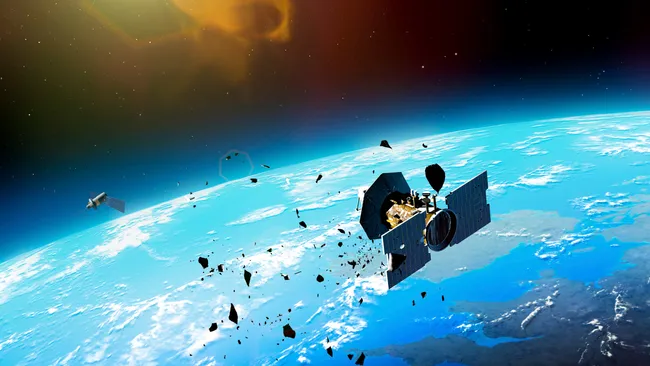China’s First Satellite Launch Marks the Beginning of a Rival to Starlink
A recent Chinese satellite launch has introduced significant amounts of space debris, posing potential risks to spacecraft operating in low Earth orbit (LEO). The Long March 6A rocket, which was launched on August 6 from the Taiyuan spaceport, aimed to deploy the first batch of communications satellites for Shanghai Spacecom Satellite Technology (SSST). This launch marks the beginning of what is intended to be a massive constellation of over 14,000 LEO satellites.

Starlink and the Rise of LEO Internet Constellations
China’s ambitious plans for a mega constellation are part of a broader trend towards LEO satellite networks aimed at providing global internet coverage. A prominent example of such an initiative is SpaceX’s Starlink. Starlink, developed by Elon Musk’s SpaceX, currently has more than 6,200 satellites in LEO, providing broadband internet services across the globe.
Starlink satellites typically orbit at a height of around 550 kilometers, allowing for rapid data transmission between satellites and Earth. This is in contrast to older internet satellite services that rely on geostationary satellites orbiting at much higher altitudes, resulting in slower data transmission speeds. Starlink’s low orbit enables it to support high-bandwidth applications like video streaming, online gaming, and other activities requiring low latency.
China’s Thousand Sails constellation aims to compete with Starlink by deploying over 15,000 satellites in LEO, offering similar global internet services. This marks a significant escalation in the space technology battle between China and the United States, as both nations vie for dominance in the rapidly expanding space internet sector.
The Launch and Resulting Debris
The Long March 6A rocket’s upper stage, designed for multiple restarts and satellite deployments, successfully placed 18 flat-panel Qianfan (“Thousand Sails”) or G60 satellites into an 800-kilometer-altitude polar orbit. However, this mission also generated over 50 pieces of debris, detected by Slingshot Aerospace, a space-tracking and data analytics firm. These debris pieces were identified using Slingshot’s Horus optical fences, which captured unexpected objects moving along the same orbital path as the rocket and its deployed satellites.
Impact on Space Operations
The creation of this debris field is concerning as it poses risks to other LEO constellations below the 800-kilometer altitude mark. According to U.S. Space Forces – Space (S4S), the breakup of the Long March 6A rocket stage occurred on August 7. The debris, traveling at approximately 27,000 kilometers per hour, can remain in orbit for decades, depending on various factors such as size and density. Any collision with an operational spacecraft can cause severe damage and generate additional debris, further complicating space operations.
Repeated Incidents and Concerns
This recent debris incident is not isolated. The upper stage of the Long March 6A has previously been associated with similar events. In early July, multiple debris pieces were detected by Swiss firm S2a Systems. In November 2022, another breakup event involving the same rocket stage resulted in hundreds of debris pieces.
Megaconstellation Ambitions
SSST plans to launch an additional 90 satellites within this year. The first phase of their megaconstellation involves deploying 1,296 satellites across 36 polar orbital planes. The overall goal is to establish a network of more than 14,000 satellites, potentially requiring frequent use of the Long March 6A rocket. This raises significant concerns about the increasing amount of space debris.
“If even a fraction of the launches required to field this Chinese mega constellation generates as much debris as this first launch, the result would be an untenable addition to the space debris population in LEO,” stated Audrey Schaffer, Vice President of Strategy and Policy at Slingshot Aerospace. This highlights the urgent need for adherence to space debris mitigation guidelines and robust space domain awareness capabilities.
China’s Space Endeavors
China’s space program has been rapidly advancing, with over 800 satellites currently in orbit. The nation aims to launch more than 290 spacecraft on around 70 missions this year, according to the China National Space Administration. The Thousand Sails constellation is part of a broader strategy to challenge existing space internet services like SpaceX’s Starlink.
Future Prospects and Global Impact
By 2025, China plans to deploy 648 satellites in the first phase of the Thousand Sails project, aiming for global internet coverage. The increasing frequency of launches and the ambitious scale of these megaconstellations underscore China’s significant role in the future of space exploration and commercial satellite services.
However, the persistent issue of space debris necessitates international cooperation and stringent regulatory measures to ensure the sustainability of space activities.
You may like this:
Subscription-Based Astronomy: How Blue Skies Space is Changing the Game
Your blog is a true gem in the world of online content. I’m continually impressed by the depth of your research and the clarity of your writing. Thank you for sharing your wisdom with us.